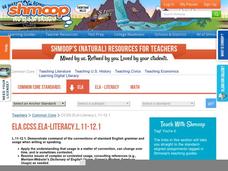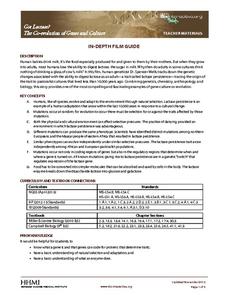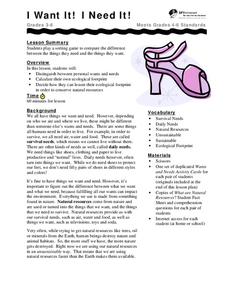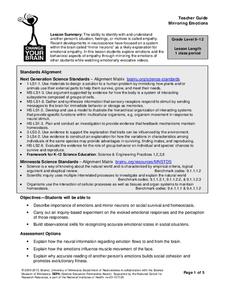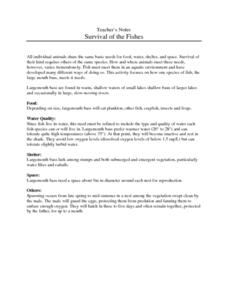Curated OER
Protect the Primates
Students make posters about saving the primates. In this primates lesson plan, students discuss primates and environmental changes and make posters with pictures about saving primates.
Curated OER
Which Animal Lives Where?
Use this lesson in your classroom for a quick and easy way to review animal habitats. Young children use magazine clippings, pictures provided, or other resources to create a collage depicting an animal habitat. This is a great way to...
Curated OER
Externalities, Property Rights and Pollution
High schoolers identify the various externalities for any type of production. Using that information, they examine situations in which they are positive and negative. They discuss government efforts to protect the environment and humans....
Curated OER
How We're Connected
Students take a survey in order to find out how they live in relationship to the environment. They take the time to investigate the differences between a need and a want. This is done as part of the self-assessment. Students also study...
Curated OER
Australia
Using their discussion notes Middle schoolers engage in a series of learning centers. Each center focuses on a different aspect of Australian geography, history, government, culture, and natural environment. Activities are briefly...
Curated OER
Weather of Your Dreams
Students explore different types of weather and its effects on the environment. They imagine unusual types of weather conditions that could fulfill their dreams. Students represent themselves and their dreamy weather in a creative...
Curated OER
Physical Agents for Microbial Control
In this biology worksheet, young scholars take part in an examination of the graphic organizer to determine the different types of environments and how they effect the survival of microbes.
Curated OER
Including the Disabled Student
Students read and discuss the history of special education in public schools related to the Individuals with Disabilities Education Act. Students work in groups to design ways to modify classroom activities based on the needs of a...
Curated OER
Adaptations
Cacti have special adaptations for living in desert heat and dryness. Polar bears have adaptations that allow them to withstand icy conditions. Humans adapt to different conditions by wearing appropriate clothing or building homes...
Shmoop
ELA.CCSS.ELA-Literacy.L.11-12.1
Despite English grammar rules, in the e-world the plural of mouse is mouses. lol. Standard American English is constantly evolving. Introduce your class members to a variety of terms that describe different usage changes (economy,...
Howard Hughes Medical Institute
Got Lactase? The Co-Evolution of Genes and Culture
Does the human body evolve as quickly as human culture? With a stellar 15-minute video, explore the trait of lactose intolerance. Only about 1/3 of human adults seem to still have the enzyme lactase and therefore, the ability to digest...
City and County of San Francisco
I Want It! I Need It!
Discuss wants and needs with your elementary ecologists and get them to consider what would happen to our natural resources if we all got everything that we want. Learners play a card sorting game and take an ecological footprint quiz on...
Facing History and Ourselves
Preparing Students for Difficult Converstaitons
Many of the issues facing 21st Century learners are challenging and even discussing these issues can be a challenge. So how do teachers prepare learners for these difficult conversations? How do instructors create a safe classroom where...
California Academy of Science
Optimal and Sustainable: Renewable Energy Revamp
More than 100 cities around the world have shifted from fossil fuels to renewable energy sources. Scholars investigate a city wanting to make this switch, but needs help determining how to make the shift. Groups consider all options,...
Smithsonian Institution
Who's in Camp?
Pupils complete readings, a group activity using cards, and a writing activity to better understand people's lives during the American Revolution. The resource emphasizes people such as the militiamen, women, officers, and children,...
Virginia Department of Education
The Effects of Heat and Acid on the Enzyme Catalase
How quickly do enzymatic reactions occur? Assist the class as they examine heat and pH change to determine the rate of chemical reactions using catalase as an enzyme. Watch them "glow" with excitement!
National Wildlife Federation
Citizen Science to the Rescue!
You don't have to be a scientist or even out of high school to contribute to scientific research. In the 12th lesson in the series of 21, scholars use this opportunity to add to the growing body of scientific knowledge and consider the...
University of Minnesota
Mirroring Emotions
Do you ever give your class the "teacher look"? Without saying a word, they become silent and engaged (hopefully). How do they know what you're thinking? Explore the concept of nonverbal communication and how it relates to our...
Curated OER
Activity 1: The Effect of Cold on Characteristics Important to Fishes
Students explore how organisms are adapted to live in the ultimate of extreme environments. They discuss the reasons for the similarities and differences between them, themselves, and the more familiar organisms around them. Students are...
Curated OER
Pond 1: Pond Life
Students work together to investigate familiar and unfamiliar ecosystems. Using the internet, they discover how different organisms use their environment to satisfy their needs. They also examine the relationshiops between organisms...
Curated OER
Urban Safari: A Walk on the Wild Side
Learners discover the urban ecosystem through a series of activities. They explore both the biotic and abiotic factors of the urban environment.
Curated OER
Mississippi Gulf Coast Islands
Fourth graders complete a variety of exercises as they study the creation, history, and geography of the Mississippi coastal islands. They discover the natuaral forces that act on the islands and how these forces affect the habitats and...
Curated OER
Motte Rimrock Reserve: Lesson Plan for Flora
Students study the flora of Motte Rimrock Reserve while observing organisms in their natural environment. They use a dichotomous key to identify plants.
Curated OER
Survival of the Fishes
Pupils study the aquatic environment in which largemouth bass are able to survive. They participate in a mystery animal activity based on their own basic needs to determine the identity of the largemouth bass.











